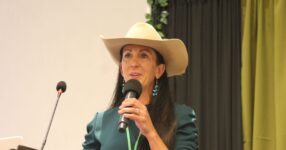
Research shows solar panels benefit land, animals – AgriNews
ROSEMONT, Ill. — Agrivoltaics works and it is going to keep growing in the United States.
“It all starts with large herbivores and ends with herbivores because we’re building solar on lands that were previously grasslands,” said Anna Clare Monlezun, founder and grazinglands and livestock management facilitator at Graze LLC.
“There’s lots of land that is not farmable, but it can be used by livestock to produce food in a way that is harmonious with ecosystem health,” said Monlezun during a panel discussion at the Solar Farm Summit hosted by the American Farmland Trust.
“Where agriculture happens is typically the ideal place for solar panels to be installed because they both need to capture photons,” said Monlezun, who is also a cattle and sheep rancher with her husband in central Colorado.
“I’m motivated by the challenge to find a way to use land for energy while reducing the land conversion tradeoff and grazing is a solution to this,” she said. “We don’t need to look at this as an either/or scenario.”
The herbivores’ role in rangeland health is essential, Monlezun said.
“When we add a solar canopy to native or cultivated grazing lands which are already complex systems, things get more complex to manage,” she said. “There is the nutrient cycle, the energy cycle and the water cycle, then we stack on that the cultivation of the land and then we have permitting and infrastructure.”
While the practice of grazing agrivoltaics is spreading like wildfire, Monlezun said, the science is trying to catch up.
“What we know so far has come from a handful of studies,” Monlezun said.
“The benefits of grazing we’ve learned from early research is showing there are definite benefits to the land including reduced evapotranspiration, reduced soil surface temperature, improved soil moisture retention and improved forage quality,” she said.
Certain grasses and plants do better in more shade or more sun.
“This creates diversity across the solar array and that’s very positive for grasslands resilience,” Monlezun said.
The research studies for sheep and cattle show reduced heat stress, improved thermoregulation, improved feed efficiency, longer rumination, reduced water consumption rates, improved average daily gain and improved dressing percentage, Monlezun said.
“We are also learning there are social and economic benefits,” she said. “By having a human presence, that can save time and money for the technicians and ranchers can be trained to recognize issues and even make small repairs.”
:quality(70)/cloudfront-us-east-1.images.arcpublishing.com/shawmedia/TQTCCXGKAVFX3LWLZ34O5T54YI.JPG)
A study found that 80% of respondents are likely to be accepting of solar projects if they incorporate agriculture, Monlezun said.
Since there are questions and challenges for grazing cattle and sheep under solar panels, the rancher said, more research is important.
“To make this new frontier in solar energy sustainable and resilient, we need to be very intentional,” Monlezun said.
“Not everywhere is going to be good for every practice so we need to create partnerships that have value for both solar and livestock,” she said. “And not all humans will have the desire or skill set to graze at a solar array so we need to consider stockmanship and the breed of livestock.”
EDF Renewables
“Cattle grazing on solar projects is one of the biggest movements to see solar as more acceptable,” said Josh Bennett, a developer for the wind and solar company, EDF Renewables.
“When I work with cattle ranchers, that gives me access to flatter and easier land to build on which reduces the amount of grading and also reduces the number of landowners,” he said during the discussion. “That can streamline the development timeline.”
In addition, Bennett said, there is a potential to reduce vegetative management costs.
“We’re working that into contracts,” the solar developer said.
“Almost every project I’m developing in upstate New York is dairy or beef,” he said. “Grazing animals is going to create a far more resilient ecosystem and cattle will improve soil quality and water retention which eases my concerns for storm water management.”
Currently, Bennett is working on an 1,800-acre solar project with three landowners.
“They are on the verge of foreclosure due to consolidation within the dairy industry,” he said. “So, I see this as an opportunity to help those families and still produce energy.”
Bennett does not expect to make significant changes to the standard design of solar projects that have livestock grazing.
“We’re comfortable keeping the solar panels at seven feet and the row spacing at 17 to 20 feet,” the developer said. “But not all cattle are going to work.”
“We’re seeing the changes add about 10% to the cost of energy and you may see 2% energy losses, but I think that’s overstated,” he said. “I believe getting cattle grazing on a larger scale can really alter the projection of solar projects.”



